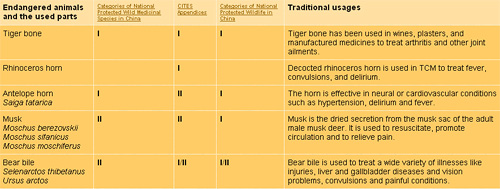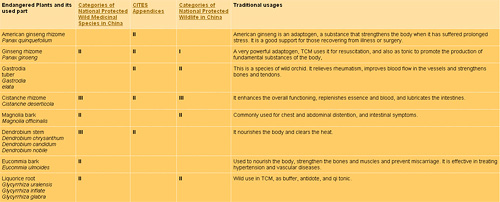TCM and the Use of Endangered Species
Introduction
TCM is a system of healthcare in which patients are treated with natural plant, animal, and mineral remedies. Its basic premise is, for a person to be healthy, vital energy (qi) must be able to move easily through the body and that yin and yang forces are in balance. Imbalance is what leads to illness or injury. TCM is about restoring smooth movement of vital energy and keeping yin and yang in balance.
TCM's origins are steeped in ancient Chinese history. The legendary Shen-nong, who was said to have invented agriculture and tasted hundreds of herbs to see their effect on the human body, is credited with compiling a catalogue of 365 species of medicinal plants that later became the basis of Chinese herbology, and the earliest completed Chinese pharmacopoeia reference.
According to TCM, it is vital that the body reflects the universal order, and this includes the non-human environment. Chinese medicine always emphasises the harmony and balance between mankind and the environment, and natural resources are the material basis of TCM treatment. This is why some discussion is needed about the controversial topic of the use of endangered species in traditional Chinese medicine; a rich supply of natural resources ensures the sustainability of TCM.
Roughly speaking, TCM practice uses about 1200 medicinal substances, in which plants cover more than 85%, animals about 10% and the remaining are minerals. Approximate 600 types are regarded as essential substances, 300-400 can be found in herbal shops, while the most commonly used substances include over 100 types.
Rare and Endangered Wildlife in TCM
TCM has used many different plant and animal species over the preceding millennia. This age-old practice has accumulated abundance experiences in the use of natural substances, and developed a unique theoretical system to guide the clinical application. Modern clinical experience and research have shown that Chinese medicine can effectively treat many diseases, in particular if these herbs and materials are prescribed in formulae according to traditional Chinese medical theories. In the last decades, the fast growing population, flourishing economy and technological development have greatly changed the global environment, causing exploitation of natural resources. Some of the TCM herbs and materials are what we now consider endangered species that rank high on the list of environmental protection issues.
There has been evidence that some now rare plant or animal species could effectively treat complicated disorders. For example, rhinoceros horn (banned) has been shown to effectively control the secondary fever and inflammation induced by chemotherapy in acute leukemia. Bear bile can be used to dissolve the bile stones or treat liver problems.
Over time, and as the human population has grown, once-plentiful species have been decimated. Their increasing rarity meant increased prices for these species and thus a brisk trade in them. This has caused organizations and individuals to campaign about the use of rare and endangered plants and animals in Chinese medicinal preparations.
The latest focus on wildlife conservation is to collaborate with traditional local industries in promoting the public awareness. See recommended resolutions of traditional medicines.
International Legislation
TCM relies on natural resources to practice; however, more and more ingredients listed in TCM pharmacopoeia are reaching endangered status. The statistics might seem insignificant now, but for wildlife whose numbers are dwindling, it is too big. Therefore, international bodies and local governments have initiated legislation to help curb the use of endangered animals and plants in traditional and complementary medicine.
The Convention on International Trade in Endangered Species (CITES)
The Convention on International Trade in Endangered Species (CITES) is an international agreement, signed by over 160 countries. Its aim is control trade in over 30,000 endangered species, and products made from them, by regulating imports and exports. In the case of some of the most endangered species, all commercial trade is banned. The CITES website has lists of endangered plants and animals. China has also enacted a number of laws and regulations to protect these species, including acceding to CITES, promulgating its own law to protect wild animals. See the China Wildlife Conservation Association website: http://en.cwca.org.cn/Article/Index.asp
Every year, the international wildlife trade is estimated to be worth billions of dollars. Millions of wildlife had been traded between countries, not only sold as live specimens but also produced in foods, leather goods, furniture, timber, tourist curios and medicines. Generally, the conditions applied for protection are subject to national laws that usually vary from one country to another.
The CITES Appendices provide extensive lists of endangered species:
 |
Appendix I: the most endangered species, international trade is permitted only in exceptional circumstances. |
 |
Appendix II: not necessarily a threatened species, international trade is closely controlled. |
 |
Appendix III: species that are protected in at least one country, international trade is allowed only on presentation of the appropriate permits or certificates. |
Resolving the Problem: Substitution or Domestication
Research has been undertaken to find effective, plentiful and safe substitutes for these and other endangered species. Methods include domestication of wild species; synthesizing the active substance from the natural material; making synthetic versions of the substance; and using a similar species to that of the endangered one.
 |
Domestication of wild species
The raising of rare animals on farms is one method of overcoming the problem. In this way, many rare species can become domesticated species. For example, the breeding of spotted deer or bear can provide adequate TCM medicinal supplies for the market, and so has held back the illegal hunting of these animals. |
 |
Artificially synthesizing the active substance
Discovering the active substance within the natural product that has the medicinal effect means that the endangered animal or plant need not be harvested from the wild. For example, scientists can now commercially synthesised musk. |
 |
Using a similar species to replace the endangered species
A practice that is popular is the substitution of a similar species of animals or plants to replace the wildlife and endangered ones, such as buffalo horn replacing rhinoceros horn. This research was done as far back as the 1970s and the buffalo horn was officially listed in the Chinese Pharmaceutical Code (1985). |
A practice that is popular is the substitution of a similar species of animals or plants to replace the wildlife and endangered ones, such as buffalo horn replacing rhinoceros horn. This research was done as far back as the 1970s and the buffalo horn was officially listed in the Chinese Pharmaceutical Code (1985).
The Problem of the Naming of Products in TCM
Misunderstandings about TCM can arise due to the naming practices of traditional Chinese medications. For example, many products have the name "tiger bone" on their packaging/list of ingredient do not actually contain real tiger bone. These are simply manufacturers following the traditional prescription name. Sometimes a label on a product tries to convince the consumer that the product contains a genuine item such as tiger bone; such is the reputation for substitutions to occur. It is difficult to be certain of the actual level of use of endangered species in prepared Chinese medicines as a result.
However, products which list certain endangered species an ingredient, whether genuine or fake, help fuel a demand for real tiger bone and products containing it. The only ethical solution is to ensure no endangered species are contained in the products, and to ensure labelling is accurate and not false. CITES has resolved that if a CITES-listed species as an ingredient on a medical product's packaging, the product should be treated as containing that species.
It then becomes the responsibility of TCM manufacturers and traders to ensure a product or preparation neither contains any endangered species, nor is labelled as containing them. The issue of labelling is an important one for the TCM profession to address.
Encouraging People to Give Up Trading in Endangered Species
Because rarity seems to be synonymous with quality, there is a flourishing market in endangered species for traditional medicines and aphrodisiacs. We must educate the TCM community and the manufacturers of TCM about CITES and other animal protection laws that using endangered species is not sustainable.
Advice for Consumers
TCM users also need to be aware the quality of substitutes is not lower than the traditional product used, otherwise the trade in endangered animals will continue.
If you buy a TCM please make sure that you do not buy any that contain endangered species. It is not always easy to know what different medicines contain, but if you are not sure, ask before you buy, particularly if illustrations of animals are shown on the packaging. It is important to stop the demand for products made from endangered species because it is this which drives the trade. If there isn't a market for the product, the producers will disappear.
Some Endangered Animals and TCM

Some Endangered Plants and TCM

*Click to enlarge the tables
Useful Links
|